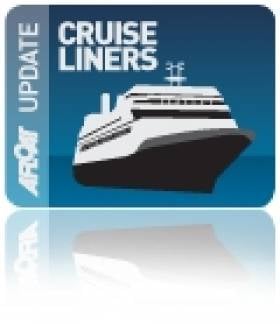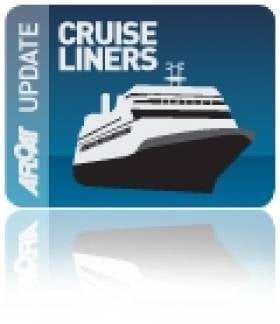Displaying items by tag: bunkers
Cruiseships Head for Cobh in advance of Queen Elizabeth
The 2,500 passenger Jewel of the Seas has a nine-deck centrum which has glass lifts which allows light to flow throughout the spacious and airy ship. Activities range from golf to climbing, a spa and sumptuous restaurants.
When the 2004 built cruiseship docks at the dedicated cruise berth at Cobh in the early hours of tomorrow she will also be sharing the deepwater berth with the 2001 built Silver Whisper. The ultra-luxury vessel accommodates only 388 passengers and is operated by SilverSeas Cruises. To read more about the vessel click HERE.
Both vessels are scheduled to depart Cobh around teatime tomorrow and this will be followed by preparations of the picturesque town which is to welcome the maiden call to Cobh of Queen Elizabeth on Saturday. To read more about the newest vessel of the Cunard Line fleet click HERE. The 2010 built vessel will firstly make an inaugural call to Dublin on Friday prior to the Cobh call which coincides with Cork Harbour Open Day, for event details visit www.corkharbour.ie
Cruiseship Calls to Dublin Includes Ship-to-Ship Refuelling
Some six hours previously Swan Hellenic's sleek Minerva (1996/12,500grt) picked up a pilot off Dalkey after sailing overnight from Portsmouth. She was followed astern by Saga Cruises Saga Ruby (1973/24,292grt) from Dover and likewise she too picked up a pilot close to the South Burford bouy. Incidentally Minerva had operated for Saga Cruises as their Saga Pearl but in recent years she has returned to her original name.
The classic lines of Saga Ruby are attributed to her combined ocean liner/cruiseship design when launched Vistafjord in 1973. The vessel was built by Swan Hunter Shipbuilders for Norwegian America Line. A decade later she was sold to Cunard Line who retained her original name until 1999 when she became the third Caronia. To read more about this former 'Cunarder' click HERE and how her interior looks now click HERE.
Dawn Princess departed Dublin this mid-afternoon bound for Cobh. Minerva is to due to leave around midnight while Saga Ruby remains overnight, in fact her call is particularly leisurely as she does set sail from the capital until tea-time tomorrow.
- Dublin Port
- Cobh
- Cruise Liners
- bunkers
- dalkey
- Princess Cruises
- Cobh Cruise Terminal
- Cruiseships
- Port of Dublin
- Ports and Shipping News
- Ocean Pier
- Cunard Line
- Cruiseliners
- Saga Cruises
- Saga Ruby
- Caronia
- Cruise Liners news
- Cruise ships
- Swan Hellenic Cruises
- Dawn Princess
- Minerva
- Refueling
- Dublin Cruiseships
- Dublin cruisecalls
- Saga Pearl
- Coastal tanker
- South Burford bouy
- Cunarder
Tankers Load Fuel in Dublin Bay
In a highly unusual procedure, a tanker took on bunkers (loading of fuel) while anchored in Dublin Bay. The procedure took place on 2 August when the Whitstar (2,159gt) moored alongside the larger Pembroke Fisher (9,356gt) writes Jehan Ashmore.
The Whitstar had arrived from Dover to conduct bunkering. The vessel approached the Pembroke Fisher to tie mooring ropes amidships, fore and aft.
The bunkering took several hours to complete. With bunkering complete, the Whitstar proceeded to the Clyde. Incidently, a fleetmate of Whitstar, the Whitchampion arrived at Dublin port earlier during the summer to load bunkers for a large cruiseship. While the re-fueled Pembroke Fisher returned to anchor overnight off Dalkey Island.
Prior to the bunkering operation, Pembroke Fisher had spent several days at anchorage south of Dalkey Island after discharging petroleum products at Dublin Port.
It is also unusual for commercial shipping to take anchorage off Dalkey Island while close to Killiney Bay. Otherwise, it is the norm for vessels to anchor in Dublin Bay with the majority of ships taking anchorage south-east off Dun Laoghaire.
The next day, Pembroke Fisher weighed anchor and firstly set a course for the Kish Lighthouse and then altered to proceed south down the Irish Sea bound for Milford Haven. The Welsh port is the location of one of the largest oil refineraries in the UK.

Whitstar moored alongside Pembroke Fisher on 2 August. The smaller tanker was transferring bunkers in a rare operation in Dublin Bay. Photo: Jehan Ashmore/ShipSNAPS































































